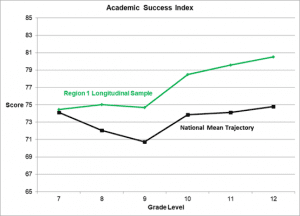 Social and Emotional Learning (SEL) focuses on developing important skills students need for academic success AND personal well-being. ACT defines social and emotional skills as “interpersonal, self-regulatory, and task-related behaviors important for adaptation to and successful performance in education and workplace”. So, SEL focuses on the teaching and development of things like relationship building, growth mindset, goal setting, expressing feelings, and study skills to name a few.
Social and Emotional Learning (SEL) focuses on developing important skills students need for academic success AND personal well-being. ACT defines social and emotional skills as “interpersonal, self-regulatory, and task-related behaviors important for adaptation to and successful performance in education and workplace”. So, SEL focuses on the teaching and development of things like relationship building, growth mindset, goal setting, expressing feelings, and study skills to name a few.
Why has ACT made SEL a priority?
ACT’s guiding principles remain to be inclusive, transformational, and holistic. Social and emotional learning is a key factor in upholding those principles. We know achievement of education and workplace success is influenced by many factors. Of course, academic knowledge is necessary, but there are other aspects that are just as important. Many of those fall under the umbrella of social and emotional skills. SEL is a natural fit for ACT as we continue to transform.
How is ACT working the SEL space?
ACT wants to empower students and educators with essential SEL skills for a lifetime of success. Over the last few years, ACT has continued to build out its SEL solutions to do just that. We know SEL must be applied to get the best results, so we’ve taken abstract SEL concepts and made them into tangible tools and frameworks for both educators and students. ACT SEL (Mawi Learning™ and Tessera®) now offers K-12 curriculum, including a specialized program for English Learners, educator professional development, and assessment that aligns with CASEL’s 5 core competencies. And as with all things ACT, these tools and assessments are firmly rooted in research and are evidence based. You can find more of our supporting research here.
 How can SEL help, specifically, empower students from underserved populations?
How can SEL help, specifically, empower students from underserved populations?
Equity in education means that we must provide every student with the education they need to live and thrive. SEL is vital to students doing just that – helping them develop the skills and habits that support success in school and beyond.
Many of the students we serve come from traditionally underserved populations and don’t have the same access to educational opportunities as their more privileged peers. A recently completed seven-year cohort study[1] ACT fielded, in partnership with Region One in south Texas, is a prime example of equity in action. The study found by using SEL assessment to identify students in need of additional supports and delivering supplementary SEL interventions to them, students in the study achieved college and career readiness at similar rates as their more advantaged peers. Region One students completed high school with a higher average academic success index score than the national sample average.
SEL can also help to break down systemic barriers that impede equity (e.g. poverty, lack of trauma-informed practices, implicit biases toward minority students). This can be achieved through a systems approach in which we challenge these barriers by embedding SEL into educational structures at every level of the system. Helping students improve college- and career-readiness skills can help students thrive in careers and break poverty cycles. SEL can also help teachers and peers recognize and reduce implicit biases; perhaps resulting in less exclusionary disciplinary practices. SEL breaks down some of these barriers and gives students from underserved populations the security and tools needed to succeed in their futures.
What are challenges faced in the world of Social and Emotional Learning?
Some of the challenges in SEL, which we’re sure educators and administrators hear regularly in schools and districts across the country, fall into the buckets of assessing need, understanding, and budgeting.
- SEL is often considered as an “add-on,” rather than as an integral part of K-12 curricula.
- SEL standards don’t always align with assessments clearly making it harder to integrate SEL into policy contexts.
- Funding for SEL can be difficult as budgets change year to year.
- Parents have questions about SEL – why their district is investing in SEL initiatives, why they should take it seriously, and what makes the new SEL program any different from other learning programs.
The conversation has changed quite a bit in the last few years and has been accelerated by the unique challenges we’re facing with COVID-19. Schools and districts now have more opportunities for funding SEL through Federal programs like Every Student Succeeds Act (ESSA), the Coronavirus Aid, Relief, and Economic Security (CARES) Act, or other competitive grants. As parents try to bridge the gap as educators from home, they are seeing the need for tools and skills to keep kids organized and motivated. School district administrators know the importance of school climate and recognize how weaving SEL into the fabric (both professional development and student curriculum) of their districts is now a must.
Why is SEL so important during COVID-19?
SEL is important at all times, but it is increasingly necessary in times of crisis and uncertainty. We can’t just jump into delivering math and science without thinking about the whole child. Are students’ basic needs met? Are their psychological needs met? SEL can bridge the gap from basic needs to learning.
As students and their families face new challenges, skills like resilience and maintaining composure become a necessity. The pandemic offers opportunities for students to practice and sharpen their skills related to pursuing goals and persisting in the face of challenge, having empathy and showing kindness to others, and exercising curiosity and flexibility.
No matter how students and educators return to learning in the fall (in-person, virtually, or a hybrid), SEL will be crucial to reconnecting with students, supporting staff and parents, and creating a safe school environment.
We have many free resources available to help educators, parents and students through this time. Check out the ACT | Mawi Learning website for lessons, videos, webinars, and access to free student curriculum through June 30, 2020.
[1] Findings from Region One’s use of SEL assessment in their 2011-2017 cohort will be available summer 2020.
